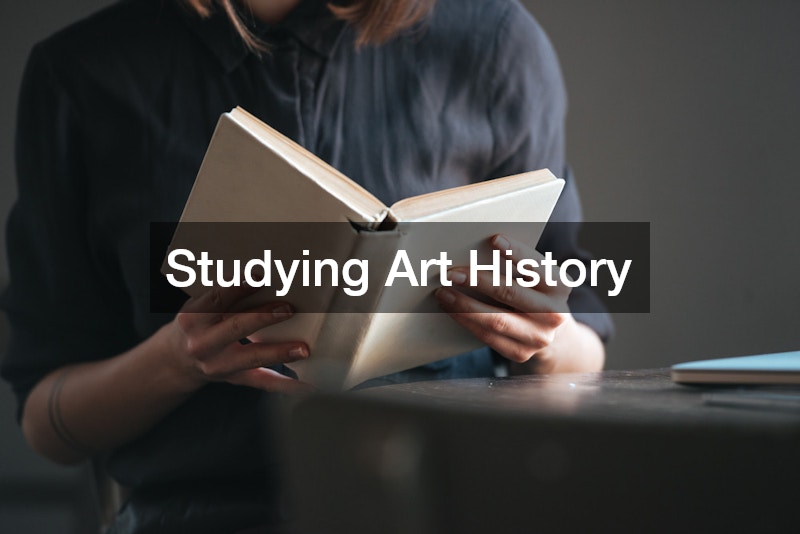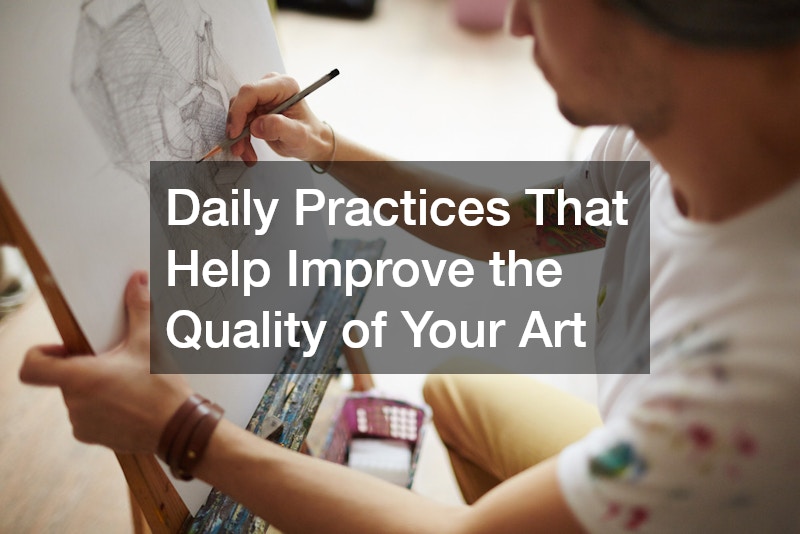As an artist, the journey toward improvement is continuous and often filled with exploration and inspiration. Daily practices play a pivotal role in honing your craft, expanding your creativity, and ultimately creating quality art that resonates with both you and your audience. By incorporating specific actions into your daily routine, such as studying art history or engaging with different cultures, you can enrich your artistic practice and elevate the quality of your work.
These daily practices might seem simple, but they carry significant weight in your artistic journey. Whether you’re creating custom jewelry for a loved one or mastering the intricacies of website design, each activity contributes to your growth as an artist. Over time, these habits cultivate not only technical skills but also a deeper understanding of the art world, sparking new ideas and avenues for exploration in your work.
Additionally, these practices provide essential breaks from traditional artistic production, allowing you to approach your art with a fresh perspective. They encourage you to step outside your comfort zone and challenge preconceived notions about creativity. Ultimately, integrating daily practices into your routine ensures a well-rounded artistic development that enhances the quality of the art you create.
Studying Art History

Art history serves as a foundational element for any artist looking to deepen their understanding of artistic practices and styles. Engaging with the stories behind renowned pieces and movements equips you with valuable knowledge that can directly inform your art. Through art restoration efforts, artists learn about techniques and materials used throughout history, gaining insights that can be directly applied to their own creative processes.
By investigating various movements—ranging from the Renaissance to Abstract Expressionism—an artist enriches their sense of style and thematic exploration. This knowledge empowers artists to create works that pay homage to earlier styles while paving the way for innovative expressions. Moreover, understanding the socio-political contexts that influenced historical art can inspire contemporary pieces that resonate with modern audiences.
Incorporating lessons learned from art history into your daily practice encourages experimentation and curiosity. For example, examining the techniques of masters can spark ideas about composition, color, and subject matter that you might not have previously considered. Ultimately, a well-rounded grasp of art history will not only improve the quality of your art but also allow you to create pieces that speak to both tradition and innovation.
Giving Custom Gifts
Creating custom gifts, such as custom jewelry, can be an enriching experience for any artist. The process of designing something unique for someone else allows you to tap into your creativity and express your artistic vision outside the realms of personal projects. This practice serves not only to strengthen your technical skills but also enhances your emotional connection to your art.
Gift-giving through art brings joy not only to the recipient but also to you as the creator. When your art is appreciated by others, it fosters a sense of fulfillment that can be hard to achieve when working solely on personal projects. This external validation often drives further exploration and experimentation in your art, prompting you to push boundaries and refine your techniques.
Moreover, each custom piece carries a story and a purpose, further motivating you to produce quality art. Engaging with others through your creative projects can also provide insightful feedback and new perspectives on your artistic approach. Overall, creating custom gifts transforms the act of making into an opportunity for personal growth while allowing your art to touch the lives of others.
Volunteering Your Time
Volunteering your artistic talents is a powerful way to contribute positively to your community while honing your skills. Whether you find opportunities to create helmet decals for a local sports team or host art workshops for children, these experiences can significantly enhance your artistic capabilities. By participating in volunteer activities, you can explore new techniques and styles without the pressure of creating gallery-worthy pieces.
This environment liberates you to experiment and practice your craft in a supportive setting. The lessened pressure often results in innovative ideas that you can carry over into your personal work. Engaging in community projects also allows you to collaborate with other artists, providing a platform for networking and learning from one another.
Additionally, the experience of using your art to fulfill a need in your community can rekindle your passion and joy in creating. Observing the impact of your contributions can serve as inspiration and motivation for future projects. Ultimately, volunteering not only benefits your artistic journey but also fosters a sense of connection and purpose within your community.
Upgrading Your Space

The environment in which you create art can have a profound impact on the quality of your work. Upgrading your space with elements like custom cabinetry can enhance your workflow by providing organized storage for materials and tools. A well-designed workspace promotes efficiency, allowing you to focus fully on your creative endeavors.
Creating a visually pleasing environment, complete with personal touches and inspiration, fosters an atmosphere ripe for creativity. Artwork, plants, and functional decor can stimulate your senses and fuel your imagination as you work. By curating a space that reflects your artistic style and passion, you’re more likely to feel inspired to produce quality art.
Furthermore, when your creative space is organized and aesthetically enjoyable, you’re more likely to spend time there, actively engaging in your artistic practice. This dedication to your environment can ultimately lead to increased productivity and artistic output. Investing in your workspace is an investment in your art and future creativity.
Trying Digital Design
In today’s digital age, exploring digital design can significantly enhance your artistic skillset. Incorporating technologies such as graphic design software into your daily practice opens up a realm of creativity and innovation that traditional mediums may not offer. From creating stunning images for print to developing dynamic website design, there are limitless possibilities to experiment with in the digital realm.
Digital tools allow artists to manipulate colors, textures, and forms in ways that are both playful and intricate. This exploration of digital media may lead to the discovery of unique styles that enrich your overall artistry. Moreover, diversifying your artistic practice ensures that you stay relevant in a world where many artists are moving towards digital platforms.
Engaging with digital design also offers the opportunity to connect with a wider audience through online publications, social media, and e-commerce. The skills developed through digital practices can complement your traditional works while attracting new potential collectors. In this way, your exploration into digital design not only enhances your artistic expression but also broadens your marketability as an artist.
Attempting New Artforms
In the pursuit of artistic growth, attempting new art forms is essential to reigniting creativity. Engaging with different media, such as pottery, sculpture, or new painting techniques found at your local paint store, pushes you beyond your comfort zone and encourages experimentation. This willingness to try new art forms can often yield fresh perspectives that transform your approach to familiar techniques.
For artists, the act of shifting focus onto a new medium can act as a reset button, affording them the opportunity to discover their capabilities anew. Each art form carries its own rules and methods, and approaching them can inspire innovative techniques for your primary practice. The resulting synergy between different kinds of art can ultimately lead to the production of quality pieces that reflect your diverse skill set.
Moreover, exploring new art forms cultivates resilience and adaptability, as artists learn to embrace the inevitable challenges that come with trying unfamiliar methods. This growth mindset is crucial in developing your overall artistic abilities, enhancing your willingness to experiment and take risks. Consequently, dabbling in a variety of art forms becomes a pivotal practice in the journey toward creating quality art.
Leaving the House

Creating art can sometimes be a solitary endeavor, but leaving the house and seeking new experiences is vital for nurturing creativity. Visiting galleries, attending art fairs, or simply strolling through parks can provide inspiration that rejuvenates your artistic practice. Engaging with the external world often illuminates ideas and concepts that can be translated into your art, driving you to innovate.
The sights, sounds, and emotions you experience when out of the house can evoke fresh ideas and perspectives. Exploring your surroundings also introduces you to different artistic styles and practices, making it easier to question your own methods and incorporate new elements into your work. Additionally, connecting with fellow artists and creatives in social settings fosters a sense of community and collaboration that can enhance your artistic journey.
Stepping outside your comfort zone fosters mindfulness and engagement with the world around you, allowing your senses to soak in new stimuli. Whether it’s a visit to local paint stores or browsing through outdoor markets, these experiences can reshape your understanding of art and creativity. Ultimately, making a conscious effort to leave the house can lead to unexpected inspiration and growth in your artistic practice.
Enjoying Your Surroundings
Creating a beautiful workspace filled with elements that inspire you is crucial for nurturing creativity. By investing in wallpaper services or decorative elements that uplift your space, you cultivate an atmosphere conducive to artistic expression. Surrounding yourself with art, personal mementos, and inspiring decor not only enhances your environment but also serves as a motivator to engage with your craft.
An aesthetically pleasing workspace influences your mood and mindset as you create. By transforming your surroundings into a sanctuary for creativity, you are more likely to find joy in the process of making art. This enhanced environment can act as a catalyst for original ideas and projects that reflect your personal artistic voice.
Moreover, when you enjoy your surroundings, it lays the groundwork for consistent creative output. A harmonious space encourages experimentation and rewards your efforts with visual inspiration that resonates with your artistic journey. Investing effort into shaping your environment is an important step toward producing quality art that truly reflects your artistic vision.
Engaging Other Cultures
Engaging with diverse cultures can substantially enrich your artistic practice, opening you up to new ideas and techniques. Participating in activities like French classes in Singapore or exploring cultural festivals exposes you to a multitude of artistic perspectives. These interactions can inspire you to draw elements from different traditions and styles, allowing you to broaden your artistic repertoire.
Learning about various customs and artistic expressions fosters a deeper appreciation for the universal threads that connect humanity through art. This understanding encourages you to incorporate unique concepts and thematic elements from different cultures into your own work. Ultimately, cultural engagement enhances the quality of your art, making it more relatable and meaningful to a global audience.
Additionally, immersing yourself in other cultures can inspire collaboration with artists from diverse backgrounds. These exchanges create opportunities to share techniques, ideas, and philosophies that can shape your individual practice. Consequently, engaging other cultures emphasizes the importance of diversity in art, leading to a richer and more fulfilling creative journey.
Moving Your Body

Physical movement is not only essential for overall health but also plays a crucial role in fostering creativity. Engaging in activities such as adult swim lessons or dance can stimulate mental clarity and enhance focus while working on your art. The physical benefits provide a refreshing break from stationary art activities, allowing for improved circulation and increased energy levels that can invigorate your creativity.
When you move your body, you unlock different channels of thought, which can be particularly beneficial for overcoming creative blocks. Many artists find that stepping away from their work and engaging in physical activity can lead to unexpected breakthroughs. This shift in focus not only refreshes your mind but also allows new ideas to flow freely when you return to your art.
Additionally, honoring your physical well-being through movement reinforces a sense of balance in your life, fostering a healthy relationship with your creative process. By embracing physical activity, you establish a routine that enhances your overall productivity and effectiveness as an artist. In this manner, moving your body becomes a vital daily practice that contributes to the quality of your art.
The journey toward becoming a better artist is enriched by incorporating daily practices that nurture creativity and skill development. Whether through studying art history, volunteering your time, or exploring other cultures, each action can significantly impact your artistic output and growth. By adopting these daily practices, you will not only improve the quality of your art but also cultivate a deeper connection to your creative process, making every step of your artistic journey rewarding and fulfilling.

